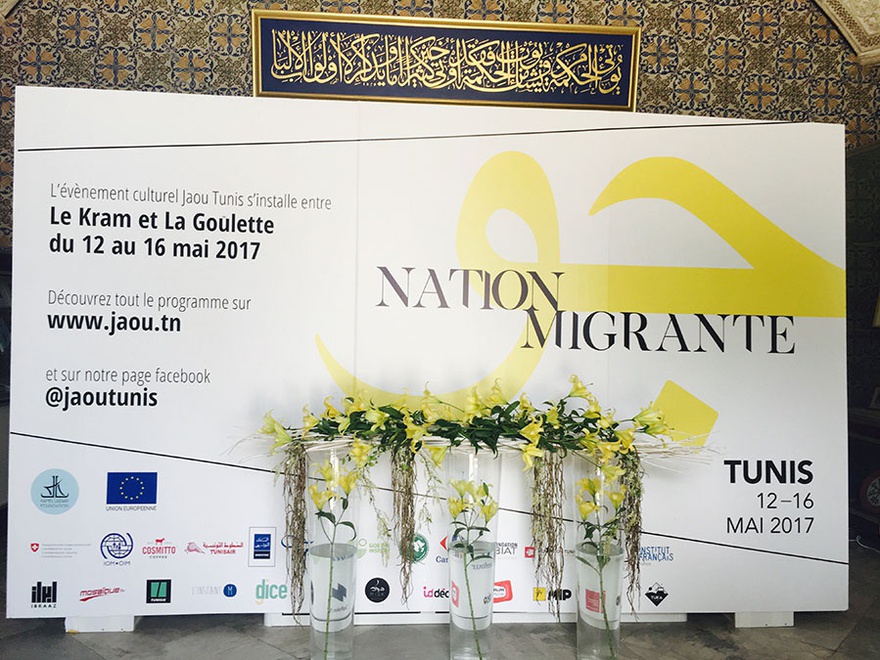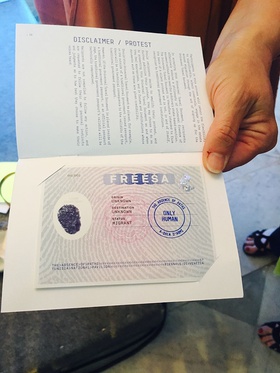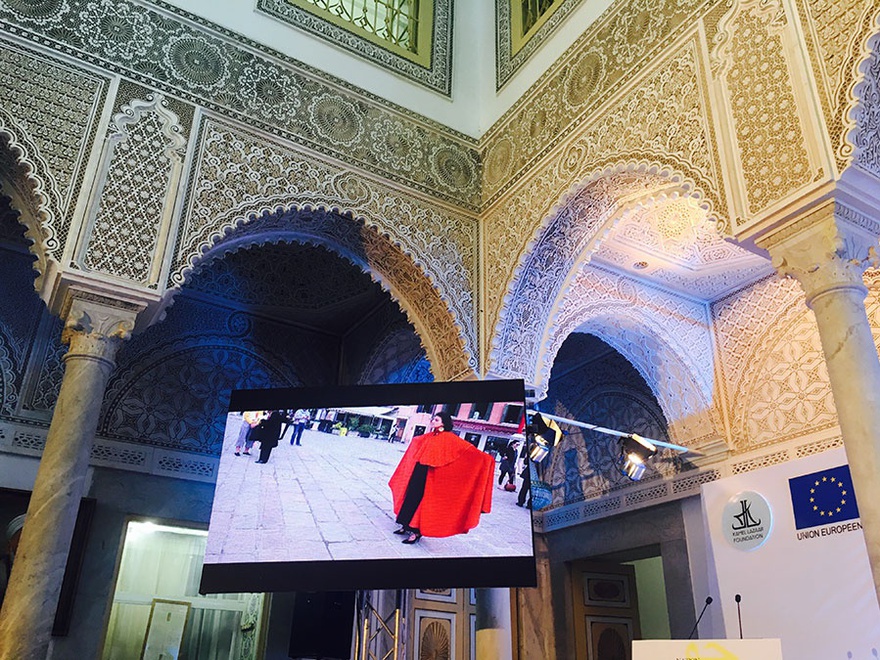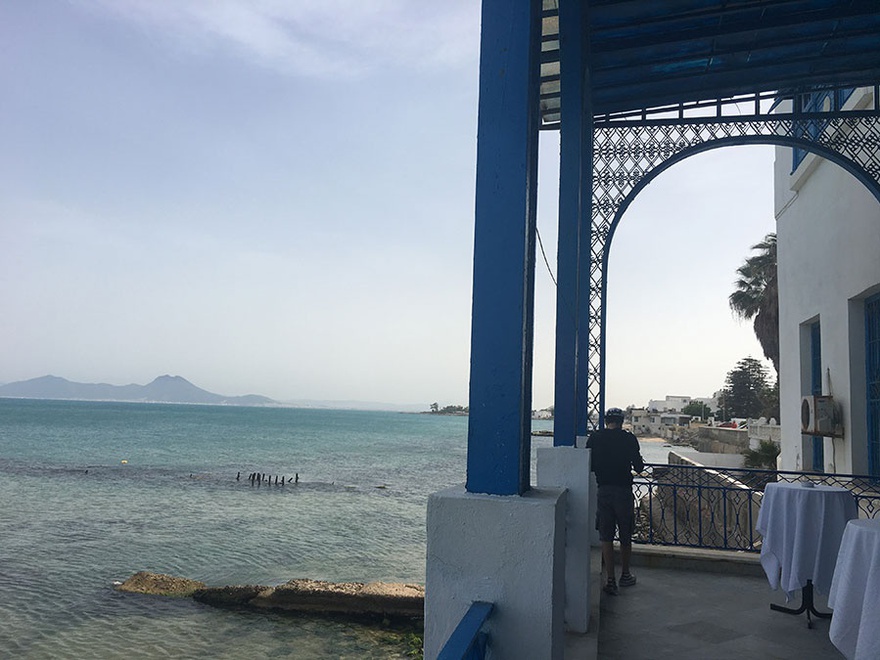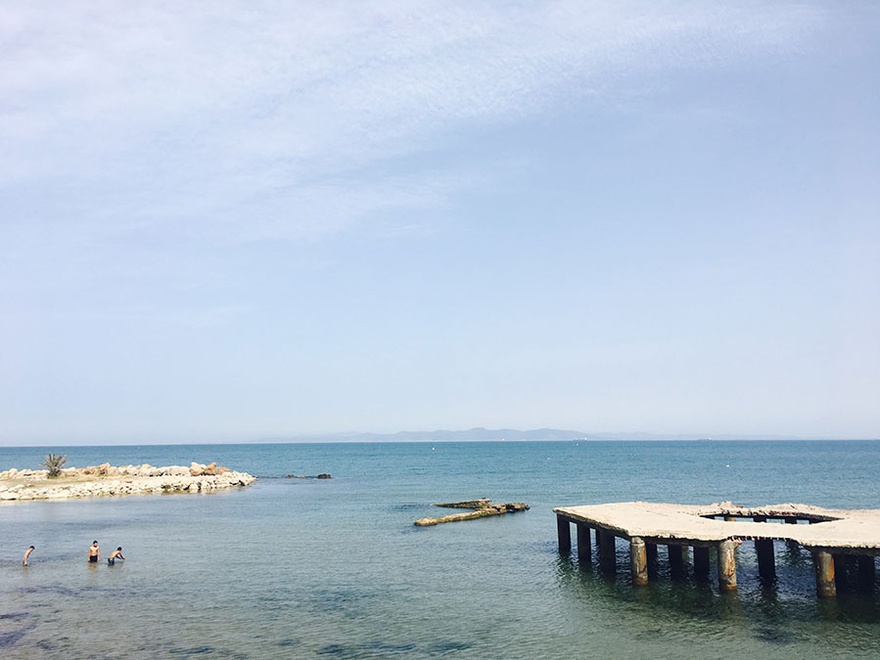News
JAOU 2017
In May, Tunisia opened its first national pavilion at the Venice Biennale in 58 years. But the pavilion was not filled with art works that represented Tunisia's rich cultural and artistic output, nor was there a single artist to be found. Instead, the curator Lina Lazaar chose migration – one of the most critical issues facing Tunisia as a country today – to take centre stage. In a performative act, the Tunisian pavilion inside the Arsenale and three other kiosks dotted around Venice issued 'freesas' to the public – documents designed to look like the Schengen visas that offer free passage around Europe but that, in this imaginary case, open up all the borders of the world to each bearer. The people issuing the visas, taking each applicant's details and thumb print, are all Tunisians who themselves dream of migrating from their home country for the promise of greater opportunities in Europe and beyond. Kamel Lazaar, the founder of the organising foundation, says that the pavilion in Venice 'is a sign of protest in the face of the discriminatory laws popping up everywhere'.
Also focussing on migration, the fourth edition of Jaou, a programme of cultural events and talks in Tunis (also created by Lina Lazaar and supported by the Kamel Lazaar Foundation [KLF]), opened two days after the launch of the performance in Venice, by which time over 4,000 people had signed up for 'freesas'. 'Migrant Nation', which included a two-day conference, an exhibition of new commissions called 'My-great-shun' and numerous other talks and events, was organised in partnership with the International Organization for Migration (IOM), a United Nations agency that aims to assist in "humane and orderly migration [that] benefits migrants and society".[1] The overwhelming message of Jaou seemed to be that migration is something that should be treated as an advantage to society and not a threat, but the discussions held during the conference revealed the complexity of the issue at hand from the perspective of a nation that is both a departure point and final destination for migrants. As Alya Sebti, one of the Jaou conference participants and the director of the Institut für Auslandsbeziehungen (IFA, Institute for Foreign Relations) gallery in Berlin, said, "We talk a lot about the subject from the perspective of where we land, but not from where we depart."
Tunisia has long been a central focus of the migration crisis in Europe. Although accurate statistics are difficult to ascertain, a 2012 national report stated the number of Tunisians living abroad to be as high as 10% of the country's total population.[2] Thousands of migrants pass through the Tunisia, some to directly embark on boats heading for Europe, but many more to enter neighbouring Libya, a now failed state from which over 90% of refugees and migrants cross the Mediterranean.[3] Alarmingly, a report published in February 2017 surveying the public opinion amongst youths in the Arab Mediterranean, found that more than half of young Tunisians would like to emigrate – a higher proportion than any of the other countries surveyed.[4]
If the performance at the Tunisian pavilion offered a utopian solution to the cross-Mediterranean migration crisis that is currently dominating debates in so many European and North African governments and societies, then the Jaou conference 'Migrant Nation' (12–16 May) in Tunis was more of a realist evaluation of the issue. The two-day conference took place at Beit el Hikma, a former 19th-century palace in Carthage and now the Tunisian Academy of Sciences, Letters and Arts. In the first panel discussion 'Migration as a Mirror of Art', Sebti started by capturing one of the central questions surrounding the representation of migration through art: "How do we manage to highlight the issue of migration with empathy rather than exoticise it as a 'hot topic'?" Sebti proffered that the answer lie in revealing the stories of individuals to counteract the faceless statistics that are continuously released in the media. She used the example of the late French-Moroccan photographer Leila Alaoui's video Crossings (2013), included by Sebti in the exhibition 'Carrefour/Meeting Point' at the gallery in Berlin, which is made up of personal testimonies from sub-Saharan migrants who had boarded makeshift boats heading for Europe. Lebanese comic book artist and filmmaker Barrack Rima echoed the need to transmit personal stories but stressed that it is not only the responsibility of artists to influence public and political opinions around migration, but of all citizens. Writer Justinien Tribillon, who spoke about The Migrant journal that he co-founded with three other like-minded individuals all spread across Europe, is an example of just such citizen action.
The second panel 'Artists in Motion' looked at the border controls that prevent Tunisian artists from being able to travel and make themselves known internationally. The lively discussion that took place both on and off stage made the frustrations around legal migratory policies clear. The Tunisian artist Meriem Bouderbala gave an impassioned speech about the struggle to be an artist in Tunisia, adding that even moving art works across borders is impossible within the current outdated laws. While Christian Reigneaud, the Consul General of France in Tunisia, spoke of the new laws put in place in late-2016 to help Tunisian artists spend up to four years in France, audience members argued that the consul wasn't processing visas quickly enough and were difficult to contact. Saima Samoud, the director of the department of music and dance at Tunisia's Ministry of Culture, explained that there has been a process of decentralisation taking place within the government since the 2011 revolution and that, after the restructuring, the ministries would be in a better position to serve the people efficiently and effectively. Samoud's comments came under much criticism from the audience who responded by saying that the ministries were "totally incompetent" and lacked structure, strategy and vision. "It is the private organisations such as KLF that are the pillars of the field of arts in this country," concluded one member of the audience.
It was fitting, then, that the second day of the conference began by looking at the role that various institutions have to play in the migration debate. On an international governmental level, Lorena Lando and Clarissa Azkoul, the director and the deputy chief of the IOM, talked about the agency's work to bring the international community together to agree on a comprehensive approach to migration issues. On 19 September 2016, the 193 UN member states signed the New York Declaration for Refugees and Migrants and a second meeting to look at the causes of migration is due to take place in New York later this year. Speaking from a national governmental perspective, Mounir Agiba from Tunisia's Ministry of Foreign Affairs talked about the privileged partnership that the country signed with the European Union (EU) in 2012, which, among other apparent benefits, allows for "increased cooperation" on citizen mobility. Agiba said that the ministry was finalising a national strategy on migration to be presented to the EU, including list of the "types" of Tunisian's who should be allowed to travel freely to Europe, but was unable (despite being pressed by several audience members) to provide a time frame for delivering the strategy and avoided questions about whether it would inhumanely privilege the rich and well-educated. As one of the many non-governmental institutions that assist migrants in Tunisia, Sana Bousbih from Terre d'Asile Tunisie spoke about how important it is to provide advice, advocacy and services to help migrants, who often find themselves in unbearable conditions after leaving their countries for unknown destinations. Hoping to help people make more informed decisions about such unknowns, Rokia Traoré, the internationally renowned Malian singer, spoke of her awareness campaign about the risks of migratory travel. Through her fame she has helped create a digital campaign that includes a trilingual website, social media sites, TV and radio adverts and a song Be aware brother, be aware sister.
Moving away from law and policy, the afternoon panel discussion looked at the back stories to migration. The panel 'The Odyssey of Migration' discussed the history of the phenomenon which, as many participants pointed out throughout the conference, is a process as old as time. The academic Raja Yassine Bahri talked about historic migration flows to Tunisia from countries such as Spain, and how migrant cultures mixed with those of their new land. Hélène Orain, the director general of Paris' National Museum of Immigration History spoke of how the museum aims to bring awareness of France's migrant history to the general public and teach tolerance within the population (within which one in four people is of an immigrant background). Orain stressed the privileged position of the museum to present such difficult subjects in a non-threatening and consumable way. 'Museums are different from non-cultural institutions. They are places in which we can reconcile the past, present and future,' she said. The panel ended with a fervent speech from the Syrian writer Fawzi Mellah, who strongly advocated an opening up of all international borders – a world where the Venice 'Freesa' was a reality – stating that Europe needs migrants to keep up with labour demands . He spoke of his disgust at a world in which globalisation meant free trade for maize and oil but not for human beings. 'Politicians say that people should stay in their countries and wait – eventually they will benefit from the crumbs of globalisation,' he said.
The final panel looked at the complex economic, political, social and cultural reasons as to why people choose to migrate. Speaking of the refugees that she represents in France, the French-Tunisian lawyer Samia Maktouf described the horrific persecution and brutality that most often leads people to flee to Europe, and especially the shocking number of children she came across. This impression was reiterated by Caterina Famularo, a psychologist working with migrants and refugees coming off boats arriving in Lampedusa. Calling into the conference by Skype, Famularo showed bright scribbled drawings from the young children she worked with, depicting bleeding corpses and people with guns. Focussing on economic migrants, a recent survey of Tunisians who undertook study in France and aimed to find out how many had returned to Tunsia was presented by Selma Belkhodja, the secretary general of l'Association des tunisiens diplômés des grandes écoles ATUGE. Of the 263 respondents, 62% remained outside of Tunisia after studying and cited the main reason as a "lack of professional opportunities" and "a lack of structure to help facilitate returning". The insightful statistics showed both the enormous brain drain that is occurring in Tunisia as well as offering foundational issues to address if the country is ever to retain some of its most gifted – and useful – citizens.
The conference ended just as Sebti had foreshadowed at the beginning of the conference – by offering a testimonial of someone who had personally migrated to Tunisia and integrated into society. Daouda Sow, a senior Tunisian state official who migrated from Mauritania, talked about being accepted by Tunisians and being able to rise to a position of authority, seemingly demonstrating the IOM's main principle and Jaou apparent raison d'être – that migration is beneficial.
It would be misleading to believe that a conference could instigate any tangible solutions to the migration crisis. But 'Migrant Nation' brought together a wide selection of participants from the fields of politics, civil society, academia and the arts to look at the issue through the prism of art and to talk about it, as Orain said, from a non-threatening space, desecuritising a discussion that is often seen as purely political. Art also allows for the ever-important testimonies of individual migrants to be expressed creatively in a way that makes us reconsider or better understand the situation. The location of Jaou's events, with venues spanning the coastline of Tunis' northern suburbs, was also unique and significant. While the Tunisian pavilion in Venice allowed the issue of migration to be brought to the attention of the art world on an international scale, Jaou offered context and reality from the ground. It is important that such discussions not only happen in 'fortress Europe' but also across the Mediterranean. Visible just beyond the walls of each venue, focussing the mind on the critical point of Jaou, was a constant reminder – the vast sea upon which so many people have set sail for Europe and under which lay those who failed.
[1] 'Mission', IOM website: https://www.iom.int/mission
[2] Office des Tunisiens à l'Etranger (OTE)/Direction de l'Information et des Relations Publiques (DIRP), 'Répartition de la Communauté tunisienne à l'étranger 2012,' www.ote.nat.tn/fileadmin/user_upload/doc/Repartition_de_la_communaute_tunisienne_a_l_etranger__2012.pdf
[3] 'Mediterranean Migrant Arrivals in 2016: 169,846; Deaths: 620', IOM website, 4 January 2017: https://www.iom.int/news/mediterranean-migrant-arrivals-2016-169846-deaths-620
[4] "Cartography of Change (Main Index)", Sahwa, Researching Arab Mediterranean Youth: Towards a New Social Contract, 12 February 2017: http://sahwa.eu/Media/Sahwa/Cartography-of-change/Cartography-of-Change-Main-Index

